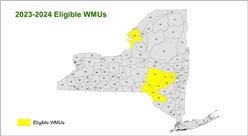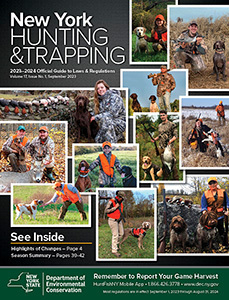Non-Lead Ammunition Rebate Program
Hunters For Eagle Conservation in New York
Lead rifle bullets and shotgun slugs are relatively soft and heavy, but can fragment into hundreds of small pieces upon impact. Gut piles from field-dressed deer can be contaminated with these small lead fragments, making them available to Bald and Golden Eagles and other scavenging wildlife that readily consume these gut piles. In recent years, ingestion of lead fragments has resulted in the impairment and death of Bald and Golden Eagles in New York.
While Bald Eagle abundance has been increasing in New York, the population growth is reduced due to lead poisoning. Golden Eagles commonly stop in New York during migration and feed upon gut piles and dead deer. Unlike Bald Eagles, the eastern population of Golden Eagles is not increasing. Therefore, lead poisoning from consuming contaminated gut piles makes the Golden Eagle more susceptible to potential population declines.
Non-lead Ammunition Rebate Program for Deer Hunters
DEC has partnered with the New York Cooperative Fish and Wildlife Research Unit at Cornell University, United States Geological Survey, and Conservation Science Global to implement a multiyear study to determine the reduction in eagle deaths resulting from use of non-lead ammunition for deer hunting. Researchers are offering a rebate of up to $60 for purchase of certified non-lead ammunition and for participation in pre- and post-hunt surveys. Certified non-lead ammunition has <1% lead content and a list of manufacturers and non-lead bullet calibers can be found at huntersforeagleconservation.org/new-york/.
To Learn More and Sign-up!
This is a voluntary program limited to wildlife management units (WMU: 3H, 4F, 4G, 4H, 4O, 4P, 4R, 4W, and 6G). Only hunters who possess a 2023–24 DMP for a WMU in the project area are eligible, and they must participate in an associated pre- and post-hunting season surveys. To learn more and sign-up, go to huntersforeagleconservation.org/new-york/. For more information on DEC efforts to minimize risks from lead ammunition please visit www.dec.ny.gov/outdoor/48420.html.
Questions? [email protected] (subject: non-lead ammo study).

Photo courtesy of Estelle S.

